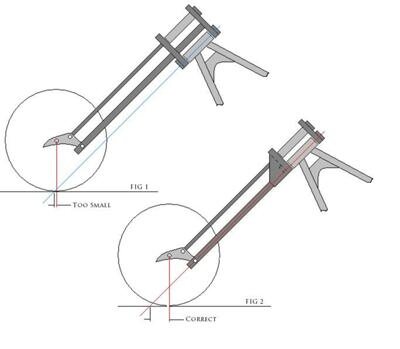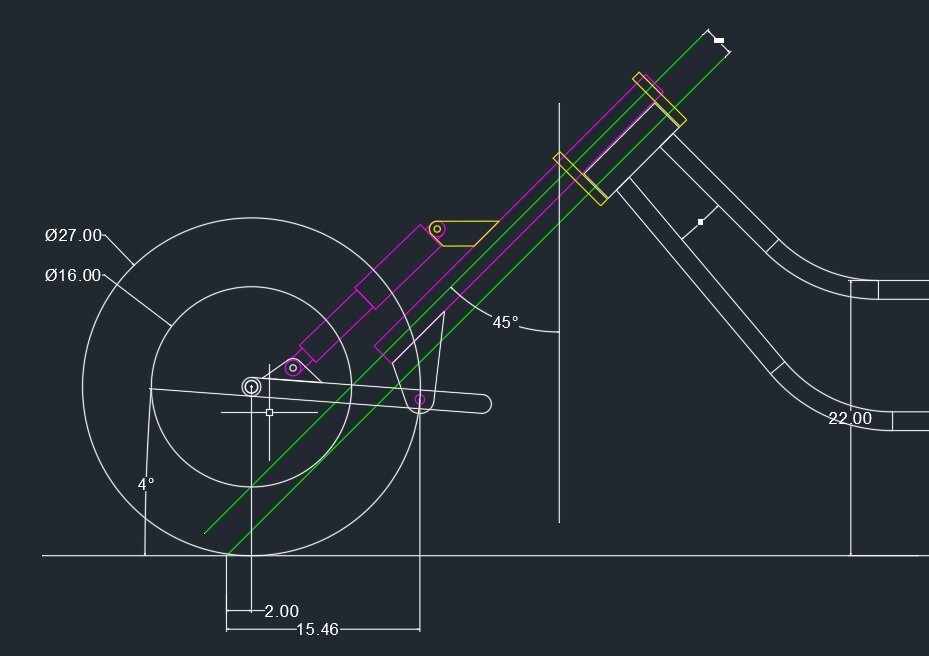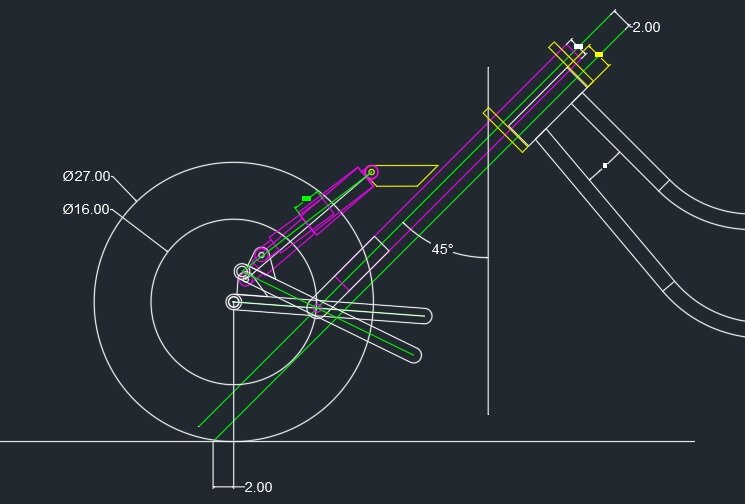Navigation
Install the app
How to install the app on iOS
Follow along with the video below to see how to install our site as a web app on your home screen.
Note: This feature may not be available in some browsers.
More options
You are using an out of date browser. It may not display this or other websites correctly.
You should upgrade or use an alternative browser.
You should upgrade or use an alternative browser.
Neck height?
- Thread starter Eggman
- Start date
So, in figure 2, it looks like the centerline of the neck is the same as the forks. How is this a good thing? I thought the forks should be in front of the neck to help with the trail.
LarryA
500+ Posts
This is the offset I was speaking of...different figures for different characteristics. Plus, clearance is needed to turn fork at a sharp angle without hitting neck frame. I located the neck bore 2 1/4 in. behind fork tubes. ( measured off of a Harley FX type bike) Fork tubes 9 in. apart, a dimension of my own choosing.
There is some good reading on this subject....I have forgotten just where!
There is some good reading on this subject....I have forgotten just where!
TomyJ
600+ Posts
Trail
Is this a senior moment Larry? :>)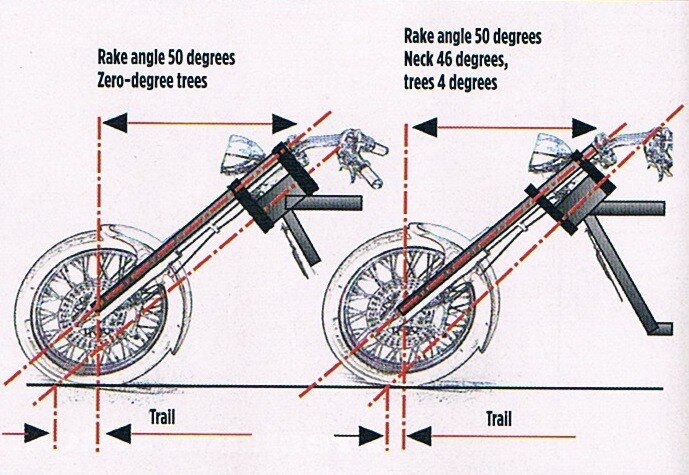
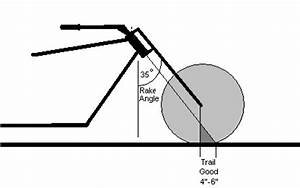
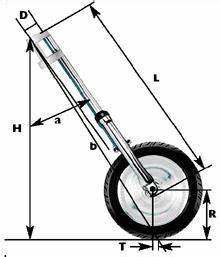 I'm learning something here also guys...[FONT=Verdana,Arial,Tahoma,Calibri,Geneva,sans-serif]Trail:
I'm learning something here also guys...[FONT=Verdana,Arial,Tahoma,Calibri,Geneva,sans-serif]Trail:
Wikipedia,
Trail[edit]
A diagram showing the effect of decreasing the head tube angle or the fork offset on the trail.
Trail, or caster, is the horizontal distance from where the front wheel touches the ground to where the steering axis intersects the ground. The measurement is considered positive if the front wheel ground contact point is behind (towards the rear of the bike) the steering axis intersection with the ground. Most bikes have positive trail, though a few, such as the two-mass-skate bicycle and the Python Lowracer have negative trail.[11]
Trail is often cited as an important determinant of bicycle handling characteristics,[12][13] and is sometimes listed in bicycle manufacturers' geometry data, although Wilson and Papodopoulos argue that mechanical trail may be a more important and informative variable,[14] although they both describe very nearly the same thing.
Trail can be increased by increasing the wheel size, decreasing or slackening the head angle, or decreasing the fork offset. Trail decreases as head angle increases (becomes steeper), as fork offset increases, or as wheel diameter decreases.
Motorcyclists tend to speak of trail in relation to rake angle. The larger the rake angle the larger the trail. Note that, on a bicycle, as rake angle increases, head angle decreases.
Trail can vary as the bike leans or steers. In the case of traditional geometry, trail decreases (and wheelbase increases if measuring distance between ground contact points and not hubs) as the bike leans and steers in the direction of the lean.[16] Trail can also vary as the suspension activates, in response to braking for example. As telescopic forks compress due to load transfer during braking, the trail and the wheelbase both decrease.[17] At least one motorcycle, the MotoCzysz C1, has a fork with adjustable trail, from 89 mm to 101 mm.[18]...[/FONT]
Is this a senior moment Larry? :>)


 I'm learning something here also guys...[FONT=Verdana,Arial,Tahoma,Calibri,Geneva,sans-serif]Trail:
I'm learning something here also guys...[FONT=Verdana,Arial,Tahoma,Calibri,Geneva,sans-serif]Trail:Wikipedia,
Trail[edit]
A diagram showing the effect of decreasing the head tube angle or the fork offset on the trail.
Trail, or caster, is the horizontal distance from where the front wheel touches the ground to where the steering axis intersects the ground. The measurement is considered positive if the front wheel ground contact point is behind (towards the rear of the bike) the steering axis intersection with the ground. Most bikes have positive trail, though a few, such as the two-mass-skate bicycle and the Python Lowracer have negative trail.[11]
Trail is often cited as an important determinant of bicycle handling characteristics,[12][13] and is sometimes listed in bicycle manufacturers' geometry data, although Wilson and Papodopoulos argue that mechanical trail may be a more important and informative variable,[14] although they both describe very nearly the same thing.
Trail can be increased by increasing the wheel size, decreasing or slackening the head angle, or decreasing the fork offset. Trail decreases as head angle increases (becomes steeper), as fork offset increases, or as wheel diameter decreases.
Motorcyclists tend to speak of trail in relation to rake angle. The larger the rake angle the larger the trail. Note that, on a bicycle, as rake angle increases, head angle decreases.
Trail can vary as the bike leans or steers. In the case of traditional geometry, trail decreases (and wheelbase increases if measuring distance between ground contact points and not hubs) as the bike leans and steers in the direction of the lean.[16] Trail can also vary as the suspension activates, in response to braking for example. As telescopic forks compress due to load transfer during braking, the trail and the wheelbase both decrease.[17] At least one motorcycle, the MotoCzysz C1, has a fork with adjustable trail, from 89 mm to 101 mm.[18]...[/FONT]
LarryA
500+ Posts
yes...lol...senior moments aplenty...good article.....listing factors and how they affect trail.
......View attachment 72806.........
So TomyJ, is what I am seeing is that the best trail is 4-6"? I'm thinking that I read somewhere that the best trail was around the 1 1/2 to 2 1/2" range. I need to have the front end easy to steer at slow speeds and no wobble at higher speeds. Which is actually best?
LarryA
500+ Posts
the current thinking is for near the 2 inch trail for a trike, but for a heavy road type motorcycle 4 to 6 inches of trail.
the 4 to 6 trail will give too heavy steering on the trike.
I will leave the (why) to someone else! My knowledge of the subject ends here.
the 4 to 6 trail will give too heavy steering on the trike.
I will leave the (why) to someone else! My knowledge of the subject ends here.
If I remember my reading correctly, this is questionable at times, is that with the trike rake, trail, and flop factor all relate to each other.
So when finding a set trail figure one also needs to see what type of flop factor they are creating with that rake and trail figures. Why is there a difference, the most I can remember is that the motorcycle has the ability to lean through corners and a trike has to steer through them. A tighter designed front end gives a better steering than a open elongated one when it comes to a trike. Also when rake angle goes past 45% angle flop factor will start decreasing and that is why 50 plus rake angles do not see flop factor issue's as much.
I do not think one particular item answers the "why" as my mind says a few factors are at play, all was so much inter related to other factors it was a bit much to wrap my mind around it all, but I did it enough to get my project going.
So when finding a set trail figure one also needs to see what type of flop factor they are creating with that rake and trail figures. Why is there a difference, the most I can remember is that the motorcycle has the ability to lean through corners and a trike has to steer through them. A tighter designed front end gives a better steering than a open elongated one when it comes to a trike. Also when rake angle goes past 45% angle flop factor will start decreasing and that is why 50 plus rake angles do not see flop factor issue's as much.
I do not think one particular item answers the "why" as my mind says a few factors are at play, all was so much inter related to other factors it was a bit much to wrap my mind around it all, but I did it enough to get my project going.
the current thinking is for near the 2 inch trail for a trike, but for a heavy road type motorcycle 4 to 6 inches of trail.
the 4 to 6 trail will give too heavy steering on the trike.
I will leave the (why) to someone else! My knowledge of the subject ends here.
I do understand where you are coming from LarryA. I'm still trying to understand the theory and actuality behind this steering/rake stuff.
If I remember my reading correctly, this is questionable at times, is that with the trike rake, trail, and flop factor all relate to each other.
So when finding a set trail figure one also needs to see what type of flop factor they are creating with that rake and trail figures. Why is there a difference, the most I can remember is that the motorcycle has the ability to lean through corners and a trike has to steer through them. A tighter designed front end gives a better steering than a open elongated one when it comes to a trike. Also when rake angle goes past 45% angle flop factor will start decreasing and that is why 50 plus rake angles do not see flop factor issue's as much.
I do not think one particular item answers the "why" as my mind says a few factors are at play, all was so much inter related to other factors it was a bit much to wrap my mind around it all, but I did it enough to get my project going.
I'm thinking that I'll start out with the trail around the 2" mark and go from there. Does the pivot point still need to be an inch or so under the front axle?
LarryA
500+ Posts
regarding the pivot point....yes as stacybg has explained, this means that the wheel axle is already started in an upward direction, then when you hit bump it just continues in that direction.....same reason that spring shackles are at an angle and not straight up and down. when a bump is hit the straight up shackle does not know which way to go!
I think Andy hit it with the increased steering effort trike vs bike. The bike can lean (maybe? lessening the effective trail) whereas the trike cannot lean, the front tire must scrub somewhat when turning....making for the increased effort.
Any math/geometry explanations regarding this problem are above my pay grade!
hope this helps!
I think Andy hit it with the increased steering effort trike vs bike. The bike can lean (maybe? lessening the effective trail) whereas the trike cannot lean, the front tire must scrub somewhat when turning....making for the increased effort.
Any math/geometry explanations regarding this problem are above my pay grade!
hope this helps!
LarryA
500+ Posts
the only thing I see that maybe be questionable, is that the lower part of the shock will move in an outward arc and not be parallel to the fork tubes during its travel. Also it will lessen the shock deflection ie weight supporting ability....this however, may be desirable way to soften the initial part of a bump.I should be pretty close with this iteration. Neck to forks is 2.5" on 45 degree angle with 2" of trail. Rocker is at a 4 degree tilt up at rest. Once I get the back half built, then I'll be able to weigh the front end and see what shocks will be used.
View attachment 72942
Hoping others take a look! I have been wrong too many times to be sure about anything!!
Well I am not a professional on this, but out of all that I read and looked at I did not see such a design.
Leading link yes, and most all had a wrap around them in the rear for stabability of the longer link arms used.
I did not like the look of the offset flange that made the forks pivot point. All I have seen pivot off the fork tubes. The welding and accuracy would be important as we want those pivot holes to be exactly even and parallel.
What I have read about leading links was that for the shocks to work there had to be a triangle effect between the fork tubes, the shock, and the link arm, hence why the shock is mounted so close to the axle hole.
The above picture showes the offset at the fork tubes causing to pull the shock parallel to the fork tube. this does work, but from what I understood and read you want the rockers to be 90 degrees to the fork tubes in the loaded riding position ( the leading link arms in the pic are much less than that ) and this might be why the triangle layout is needed.
Maybe others will chime in on it, wonder who else has tried this ?
Leading link yes, and most all had a wrap around them in the rear for stabability of the longer link arms used.
I did not like the look of the offset flange that made the forks pivot point. All I have seen pivot off the fork tubes. The welding and accuracy would be important as we want those pivot holes to be exactly even and parallel.
What I have read about leading links was that for the shocks to work there had to be a triangle effect between the fork tubes, the shock, and the link arm, hence why the shock is mounted so close to the axle hole.
The above picture showes the offset at the fork tubes causing to pull the shock parallel to the fork tube. this does work, but from what I understood and read you want the rockers to be 90 degrees to the fork tubes in the loaded riding position ( the leading link arms in the pic are much less than that ) and this might be why the triangle layout is needed.
Maybe others will chime in on it, wonder who else has tried this ?
Well I am not a professional on this, but out of all that I read and looked at I did not see such a design.
Leading link yes, and most all had a wrap around them in the rear for stabability of the longer link arms used.
I did not like the look of the offset flange that made the forks pivot point. All I have seen pivot off the fork tubes. The welding and accuracy would be important as we want those pivot holes to be exactly even and parallel.
What I have read about leading links was that for the shocks to work there had to be a triangle effect between the fork tubes, the shock, and the link arm, hence why the shock is mounted so close to the axle hole.
The above picture showes the offset at the fork tubes causing to pull the shock parallel to the fork tube. this does work, but from what I understood and read you want the rockers to be 90 degrees to the fork tubes in the loaded riding position ( the leading link arms in the pic are much less than that ) and this might be why the triangle layout is needed.
Maybe others will chime in on it, wonder who else has tried this ?
The last pic was of a setup that I thought was pretty close to the blue trike in post #38.
So, what you are saying is that the rocker should be closer to B versus A?

LarryA
500+ Posts
No expert here, but to me B looks better, this stance fully loaded driver and passenger on. Lower shock arc would be more normal. Maybe you have a program to show A and B in motion or use a card board mockup. Just something to show the motion and travel.
imo pivot about an inch below center of axle is the way to go
stacebg has built more, and knows more, about leading link systems. From what I understand and have seen it is more the ideal set up ( having your axle height that 1" above the forks pivot point. With springer front ends this is achieved with the rocker and can be a lot more distance, but that is a different design.
Having the front axle a bit higher, probably near that 5 degree angle from the fork pivot point, that 1" higher, allows the shock to follow the decompression stoke when hitting the bump, also it has some pre forward force behind it when you cover the hole. Some would say level and than rider weight would lower fork pivot point below the axle height, but I think that is bigger boys than I. I can blow away in a strong wind, LOL
I did not mean to confuse anyone, heck I could be confused myself.
I just thought having the rear pivot point back behind the fork tube was odd and not a good idea, plus more work that is not needed, but it could have been done so the desired trail was achieved. Just hope all works out for you.
Having the front axle a bit higher, probably near that 5 degree angle from the fork pivot point, that 1" higher, allows the shock to follow the decompression stoke when hitting the bump, also it has some pre forward force behind it when you cover the hole. Some would say level and than rider weight would lower fork pivot point below the axle height, but I think that is bigger boys than I. I can blow away in a strong wind, LOL
I did not mean to confuse anyone, heck I could be confused myself.
I just thought having the rear pivot point back behind the fork tube was odd and not a good idea, plus more work that is not needed, but it could have been done so the desired trail was achieved. Just hope all works out for you.
LarryA
500+ Posts
My main issue with the drawing is not the 1 inch pivot point dimension as stated by stacybg, but the length between the fork pivot and the lower shock mounting....looking at the # 38 pic the the distance between the above mentioned points, appears to be about 1/2 of rim diameter ( assuming a 16 "wheel), whereas on your drawing it must be 10/11 inches pushing the lower shock outward as much as upward. This may be an illusion on my part, but it is something I would like to see in simulation before starting the build.
stacebg has built more, and knows more, about leading link systems. From what I understand and have seen it is more the ideal set up ( having your axle height that 1" above the forks pivot point. With springer front ends this is achieved with the rocker and can be a lot more distance, but that is a different design.
Having the front axle a bit higher, probably near that 5 degree angle from the fork pivot point, that 1" higher, allows the shock to follow the decompression stoke when hitting the bump, also it has some pre forward force behind it when you cover the hole. Some would say level and than rider weight would lower fork pivot point below the axle height, but I think that is bigger boys than I. I can blow away in a strong wind, LOL
I did not mean to confuse anyone, heck I could be confused myself.
I just thought having the rear pivot point back behind the fork tube was odd and not a good idea, plus more work that is not needed, but it could have been done so the desired trail was achieved. Just hope all works out for you.
I had not noticed that my pivot was farther behind the rim edge than the pic in post #38. However, it wasn't placed there for good trail. That position, if I'm understanding trail, has nothing to do with it. Just where the steering neck and the axle straight to ground will have any impact on it. Try this one.
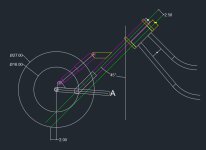
Trike Talk Community
Welcome to a community dedicated to the most diverse and fastest growing powersports segment, Motorcycle Trikes. Come join the discussion about the best makes and models, popular modifications and proven performance hacks, trike touring and travel, maintenance, meetups and more!
Register Already a member? LoginForum statistics







